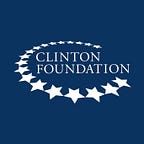3 Ways to Catalyze Smallholder Agribusiness
Agriculture is a primary source of income for 450 million households around the world. In fact, smallholder farmers account for a majority of rural employment, food production, and export earnings in many emerging economies.
Yet often these farmers haven’t realized their full economic potential due to limits on their access to high-yield farming practices, markets, and finance. Investing in smallholder farmers is one of the fastest ways to improve livelihoods and sustainably nourish a growing world population.
Many members of the Clinton Global Initiative (CGI) are taking action to help catalyze economic empowerment through innovative agribusiness projects. Here are three ways that commitments made by CGI members aim to increase yields and outcomes for smallholder farmers.
Expanding Supply Chains for Peanut Farmers
Ghana has a long history of producing peanuts, known locally as groundnuts. But the process is not without its challenges. Most Ghanaian peanut farmers work on very small plots of land and don’t have access to the resources or training that they need to produce high-quality peanuts in sufficient quantities. As a result, opportunities to improve their income by selling to larger commercial buyers are limited.
At the CGI 2015 Annual Meeting, The Hershey Company committed to train 7,500 smallholder farmers in Ghana on improved agronomic practices and to empower them to supply local commercial markets with safe, high-quality peanuts. These locally-grown peanuts will be used to produce Vivi — a peanut-based, vitamin- and mineral-fortified nutritional supplement Hershey developed and is now distributing to 50,000 Ghanaian school children each day. The Hershey Company pledged, over the next four years, to source 100 percent of the peanuts for its Vivi snack from Ghanaian farmers.
Through this commitment, the Hershey Company hopes to increase the capacity and sustainability of Ghana’s peanut supply, creating new market opportunities and improving livelihoods for generations to come. Learn more.
[[{“fid”:”8321",”view_mode”:”center_column”,”type”:”media”,”link_text”:null,”attributes”:{“height”:”360",”width”:”540",”alt”:”Harvest; Maize; Mlanda Location; Monica Ngaga (farmer); Portraits; Tanzania; 2015; 2014; One Acre Fund; Putting 1 Million Farmers First by 2020; Food Systems; Agricultural Development; smallholder farmers; Africa; farmers”,”class”:”media-element file-center-column”}[[{
Mechanizing Cassava Production
Cassava, the starchy root of a tropical tree, is a staple in many regions throughout the world. African nations are the largest producers of cassava, accounting for nearly 65 percent of global production. Despite this, crop yields per acre in Nigeria, Zambia, and Uganda are less than one third of that in other cassava-growing regions throughout the world. This is, in large part, because cassava has been produced for subsistence rather than commercial use.
In 2015, The African Agricultural Technology Foundation (AATF) committed to train 63,000 smallholder cassava farmers in Nigeria, Zambia, and Uganda on improved farming techniques, and to facilitate access to processing machinery to improve efficiencies in cassava production.
Through this commitment, AATF hopes to make cassava a preeminent cash crop for smallholder farmers in the participating regions. Learn more.
Growing a Successful Model
In sub-Saharan Africa, the International Fund for Agricultural Development (IFAD) has estimated that every 10 percent increase in agricultural productivity lifts seven million people above the $1 per day income level.
In 2015, One Acre Fund made a CGI Commitment to Action to expand the geographic scope of its programs, which seek to improve the agricultural productivity and livelihoods of sub-Saharan African farmers. Through its programs, One Acre Fund provides participating farmers with a comprehensive bundle of seed and fertilizer, finance, training, and post-harvest support. The organization’s typical client is a smallholder farmer and mother of four children who relies on one acre of land to feed her family.
One Acre Fund’s CGI commitment will scale its programs to an additional six countries, reaching a total of one million smallholder farmers in sub-Saharan Africa. It will also increase its impact by providing new products and services that promote soil health, clean energy, and nutrition.
Farmers working with One Acre Fund achieve a significant increase in their crop yields, raising their income from farm and non-farm activities supported by the model by 50 percent. By expanding its model, One Acre Fund hopes to address rural poverty on an increasing scale. Learn more.
[[{“fid”:”8322",”view_mode”:”center_column”,”type”:”media”,”link_text”:null,”attributes”:{“height”:”812",”width”:”540",”alt”:”Alain Bangirinama (man); Burundi; Coffee; Dalia Ndinduruvugo (woman); Harvest; Portraits; 2015; 2014; One Acre Fund; Putting 1 Million Farmers First by 2020; Food Systems; Agricultural Development; smallholder farmers; Africa; farmers”,”class”:”media-element file-center-column”}[[{
